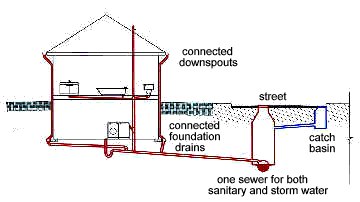
Three types of sewers are found in Toronto: storm sewers, sanitary sewers and combined sewers. Storm sewers take water that falls on our roads from the sewer grates at the side of the streets to the lake a river (such as the Don) or other stream. Sanitary sewers are intended to take waste water from houses, schools, stores, factories and other buildings to pollution control facilities (sewage treatment plants). The third type, Combined sewers, carry both waste water from the community and water from the streets. In dry weather and light rains, all the water goes to the pollution control facility, but when the amount of rain plus sanitary water reaches the capacity of the sewer, it overflows into the lake or a stream. Such an event and the outflow pipe are called Combined Sewer Overflows, frequently abbreviated to CSO.

Combined sewer system
This was the system in place in much of Toronto in the early years of the twentieth century after the Ashbridges Bay Sewage Treatment Plant, was built in 1910 and the North Toronto plant in the late 1920s. In the 1970s it was decided that “the combined sewer system that still exists in most parts of Toronto is totally inadequate.” Storm sewers were constructed under the city’s streets alongside the existing combined sewers, but little effort was made to connect house roof leaders and foundation drains to the new storm sewers in most of the city; instead, connections to the storm sewer was only required when a new building was constructed or an older one was given a major renovation. The city was going though a massive rebuilding phase at the time and it was believed that it would be only a few years until the roofs of all buildings and houses would be connected to the storm system. It would be a considerable expense and result in much damage to the roots of our fine city trees to disconnect all houses immediately. In the interim, taking the street water out of the sanitary system made a positive effect on the number of the annual CSO events.

Partially separated sewer system
The building boom slowed and citizens started treasuring and protecting our older homes. As a result, rain water falling on the roofs of most city homes still contributes to sewer overflows. This is the chief reason the city advocates the disconnection of roof leaders from the sewers wherever soil conditions permit.
The former Village of Forest Hill, with its many fine houses and mansions, was not expected to undergo massive redevelopment, so there roof leaders and foundation drains were connected to the storm sewers as sewer separation proceeded.

Fully separated sewer system
The result of this history is that we have three patterns of sewers in the city. Streets that still depend entirely on combined sewers; those where separation is complete and streets with partially separated sewers.
